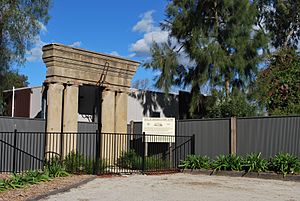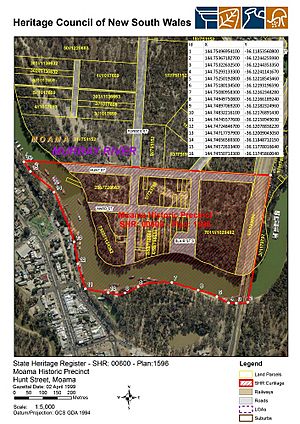Moama Historic Precinct facts for kids
Quick facts for kids Moama Historic Precinct |
|
|---|---|

Memorial at the site of the former Maiden's Punt and Inn, pictured in 2011.
|
|
| Location | Hunt Street, Moama, Murray River Council, New South Wales, Australia |
| Official name: Moama Historic Precinct; Echuca - Moama Bridge; Echuca Wharf; Murray River (part of) | |
| Type | State heritage (complex / group) |
| Designated | 2 April 1999 |
| Reference no. | 600 |
| Type | Historic Landscape |
| Category | Landscape - Cultural |
| Lua error in Module:Location_map at line 420: attempt to index field 'wikibase' (a nil value). | |
The Moama Historic Precinct is a special area in Moama, New South Wales, Australia. It used to be Aboriginal land and a busy place with wharves for boats. Today, it's a public space where you can learn about history. This important site includes the Echuca - Moama Bridge and the Echuca Wharf. It was officially added to the New South Wales State Heritage Register on April 2, 1999, meaning it's protected for its historical value.
Discovering Moama's Past
Before Europeans arrived, the land around Echuca and Moama was home to Aboriginal people. The Jodajoda people lived in this specific area. The Yorta Yorta language group lived in a wider region, from Echuca to Cobram and south to Shepparton. They were also known as the Bangarang people. Today, their descendants call themselves the Yorta Yorta Nation.
Early Explorers and Rivers
The Murray River and Campaspe River were very important for the area's growth. In the late 1830s, European settlers began exploring this region. They drove cattle and sheep inland, looking for new grazing land.
In 1838, explorers Hawdon and Bonney passed through Echuca. They wrote some of the first descriptions of the land and its Aboriginal people. Later that year, Charles Sturt followed their path. By 1841, large farms called pastoral holdings were set up along the Campaspe and Murray rivers.
John Maiden and Moama's Beginnings
In the 1840s and early 1850s, many sheep and cattle needed to be moved to markets. The Moama area became a popular spot to cross the Murray River. It had gentle riverbanks and was the shortest route to Melbourne.
In 1842, James Maiden and his wife became early settlers on the New South Wales side of the Murray. Maiden saw a chance to help people cross the river. In 1844, he built a punt (a flat-bottomed boat) to carry people and goods across. He replaced it with a bigger one in 1845.
In 1846, Maiden opened the Junction Inn near his punt. It offered food, drinks, and stables for travelers. Maiden became wealthy from the river traffic and his cattle business. A small town, mostly owned by Maiden, grew around the river crossing. He was the punt owner, innkeeper, postmaster, and cattle dealer.
In 1851, Maiden's Punt officially became known as Moama. The Victorian gold rush in the early 1850s increased the demand for meat. Maiden set up slaughterhouses, and by 1854, Moama was a major cattle market. However, the cattle market crashed in the mid-1850s. James Maiden's wealth and Moama's importance declined. In 1861, Maiden sold everything and left the area.
Henry Hopwood and Echuca's Rise
In the 1840s, Echuca did not exist. James Maiden controlled all the river crossings. In 1849, Henry Hopwood arrived near Moama. He tried to start his own punt business but faced strong opposition. In 1852, he moved across the river to Victoria.
Hopwood wanted to compete with Maiden for control of river crossings. He aimed to make Echuca more important than Moama. He started a small settlement on the Victorian side, first called "Hopwoods ferry." In 1854, it was officially named Echuca.
Between 1854 and 1857, Hopwood built a punt, an inn, stores, and other businesses. As Maiden's fortunes declined, Hopwood's influence grew. In 1859, he built a pontoon bridge and the grand "Bridge Hotel." This helped Echuca become a major stop for coaches from Melbourne.
Echuca's Growth: Transport and Timber
In 1853, steamboats began operating on the river. In 1864, the Melbourne-Echuca railway line was finished. These two events made Echuca a major center for transport and sawmilling. Both steamboats and trains needed wood for fuel or railway sleepers. So, cutting down redgum trees around Echuca-Moama became a big industry.
By 1872, the Port of Echuca was a busy hub. Wool and other goods were transported by steamboat, then by train to markets. However, as more railway lines were built across Victoria, river transport became less important.
In 1875, construction began on the iron rail and road bridge that crosses the Murray River today. The bridge was finished in 1878. It officially opened in 1879 after residents, eager to use it, opened it themselves in an event known as the "Bridge Riot." After this, the steamboat trade slowly declined.
Changes in the Timber Industry
Between 1877 and 1881, the profitable redgum sawmilling industry in Echuca faced problems. The Victorian government put a heavy tax on redgum in 1877. By 1878, 1,000 people in Echuca were jobless. Although the tax was removed in 1881, most of the redgum trade had moved to mills in New South Wales, where there was no tax.
This greatly affected the settlements tied to the sawmilling industry. In 1881, the Murray River Sawmills company was formed. Several sawmillers joined together to keep their businesses going. A sawmill still operates in Echuca today under the same name and on the same site. Logging of redgum continues, but at much lower levels.
Farming and Moama's Rebuilding
The 1860s saw the start of market gardening in the Echuca-Moama area. Chinese market gardeners arrived in 1865. By 1887, there were ten gardens supplying fresh vegetables and tomatoes. Farmers also took up land south and west of Echuca in the 1870s.
Moama developed more slowly. In 1870, a huge flood swept away most of its 40 buildings. However, the town was rebuilt. Its population grew due to new farms being created and the opening of the Deniliquin-Moama railway line in 1875.
Early 20th Century Changes
In 1881, Echuca had 4,789 people, and Moama had 700. Both towns saw a slight decline over the next 30 years. This was due to economic changes and new technologies. The port and sawmilling industries declined. The economic depression of the 1890s also reduced trade.
Traditional jobs like blacksmiths and coachbuilders became less important as cars became popular after 1910. The loss of many men during World War I meant that river transport and sawmilling never fully recovered.
However, farming and dairying in the surrounding areas became more important. In 1894, Echuca Village was created to help people during the depression. Farmers could get land if they met certain conditions. The village grew into a productive farming area by the 1920s. More farmers came to the region after 1906. Chinese market gardeners continued to thrive, and fruit and vegetable production peaked before World War I.
Between the World Wars
Echuca-Moama began to recover economically in the 1920s. Soldiers returning from the war started farms or businesses. Dairying continued to grow. The population northwest of Moama increased with a new railway line to Balranald.
Echuca remained a commercial center during the 1930s depression. Rabbit hunting became a major way for many families to earn money. Spanish immigrants and some Chinese gardeners continued market gardening.
After World War II: Industry and Tourism
During World War II, Echuca East saw economic growth. A factory and housing for workers were built there. This continued after the war when the factory was bought by the United Bearing Corporation. After World War II, returning soldiers again boosted the economy by building homes, starting businesses, or farming. Agriculture and dairy industries supported a flour mill, butter factory, and tomato processing plant.
Part of the Port of Echuca wharf was taken down in 1944. But as modern development moved away from old Echuca in the 1950s and 1960s, some people began to appreciate its history. Plans to restore the Port of Echuca began in the 1960s and were finished in 1974.
From the mid-1970s until today, tourism has become a major industry in Echuca-Moama. Steamboats were restored for tourists in Echuca. In Moama, work was done to improve Horseshoe Lagoon and the wharf. The economic boom of the 1980s brought more building and business growth to both Echuca and Moama.
What You Can See Today
The Moama Historic Precinct includes the Echuca Road/Rail bridge and the Echuca Wharf. This area was once home to Chinese market gardens, houses, a sawmill, a busy shipbuilding business, and one of the busiest boat slips on the Murray River.
Today, the land is mostly open red gum forest. You can still see the remains of the old boat slip and some machinery. The large, old hulls of two river barges also lie nearby.
Why Moama is a Heritage Site
The Moama Historic Precinct was added to the New South Wales State Heritage Register on April 2, 1999. This means it is considered very important for its history.
It shows how technology changed the way Australia's goods were transported. The Echuca Rail/Road bridge and the Echuca Wharf are key parts of this story.


